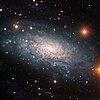Galassia di campo
Vai alla navigazione
Vai alla ricerca
Per galassia di campo si intende una galassia gravitazionalmente isolata che non appartiene ad un gruppo né ad un ammasso di galassie[1]. La maggior parte delle galassie a bassa luminosità superficiale sono galassie di campo.
Lista delle galassie di campo
[modifica | modifica wikitesto]Questa è una lista parziale di galassie di campo del vicino universo[1].
| Galassia | Tipo | Dimensioni (Migliaia a.l.) | Costellazione | RA | DEC | Distanza (Milioni a.l.) | Note | Immagine |
|---|---|---|---|---|---|---|---|---|
| Andromeda IV | dIrr | 6 | Andromeda | 00h 42m 32.3s | +40° 34′ 19″ | 22 | [2] | 
|
| IC 5152 | IA(s)m | 8,3 | Indiano | 22h 02m 41.5s | -51° 17′ 47″ | 5,8 | [3] | 
|
| MCG+07-33-027 | Sa | 104 | Ercole | 16h 02m 16.6s | +42° 55′ 01″ | 338 | [4] | 
|
| NGC 16 | SAB0- | 75 | Pegaso | 00h 09m 04.3s | +27° 43′ 45″ | 123 | [5][6] | 
|
| NGC 404 | SA(s)0 | Andromeda | 01h 09m 27.0s | +35° 43′ 04″ | 11,2 | detta "Il fantasma di Mirach"[1][7] | 
| |
| NGC 1182 | Sa | 40 | Eridano | 03h 03m 28.4s | -09° 40′ 13″ | 140 | 
| |
| NGC 1208 | S0/a | 110 | Eridano | 03h 06m 11.9s | -09° 32′ 29″ | 185 | [8] | 
|
| NGC 1313 | SB(s)d | Reticolo | 03h 18m 15.4s | -66° 29′ 50″ | 12,89 | detta "Galassia Sotto-Sopra"[1][9] | 
| |
| NGC 2188 | Sm | Colomba | 06h 10m 09.7s | -34° 06′ 50″ | 27,5 | [1] | 
| |
| NGC 2503 | SAB(rs)bc | Cancro | 08h 00m 36.7s | +22° 24′ 00″ | 254 | 
| ||
| NGC 2683 | Sc | Lince | 08h 52m 41.3s | +33° 25′ 18″ | 32,9 | detta "Galassia UFO"[1] | 
| |
| NGC 2903 | SBbc | Leone | 09h 32m 10.1s | +21° 30′ 03″ | 30,6 | [1] | 
| |
| NGC 3115 | S0 | Sestante | 10h 05m 14.0s | -7° 43′ 07″ | 31,6 | detta "Galassia Fuso"[1] | 
| |
| NGC 3621 | SA(s)d | Idra | 11h 18m 16.5s | –32° 48′ 51″ | 21,7 | [1] | 
| |
| NGC 4136 | SABc | Chioma di Berenice | 12h 09m 17.7s | +29° 55′ 39″ | 40,9 | [1] | 
| |
| NGC 4555 | E | 125 | Chioma di Berenice | 12h 35m 41.2s | +26° 31′ 23″ | 310 | 
| |
| NGC 4605 | SB(s)c | Orsa Maggiore | 12h 39m 59.4s | +61° 36′ 33″ | 15,3 | [1] | 
| |
| NGC 5068 | SAB(rs)cd | Vergine | 13h 18m 54.8s | -21° 02′ 21″ | 19,8 | [1][10] | 
| |
| NGC 6503 | SA(s)cd LINER |
30 | Dragone | 17h 49m 26.514s | +70° 08′ 39.63″ | 18,5 | detta "Lost-In-Space galaxy"[1][11][12][13] | 
|
| UGC 9240 | IAm | 15 | Boote | 14h 24m 43.4s | +44° 31′ 32″ | 9,7 | 
|
Note
[modifica | modifica wikitesto]- ^ a b c d e f g h i j k l m Jürgen Materne, The structure of nearby groups of galaxies – Quantitative membership probabilities, in Astronomy & Astrophysics, vol. 74, n. 2, April 1979, pp. 235-243, Bibcode:1979A&A....74..235M.
- ^ Annette M. N. Ferguson, J. S. Gallagher e Rosemary F. G. Wyse, On the Nature of Andromeda IV, in The Astronomical Journal, vol. 120, n. 2, 2000-08, pp. 821-832, DOI:10.1086/301485. URL consultato il 27 maggio 2020.
- ^ Albert A. Zijlstra e Dante Minniti, A Dwarf Irregular Galaxy at the Edge of the Local Group: Stellar Populations and Distance of IC 5152, in The Astronomical Journal, vol. 117, n. 4, 1999-04, pp. 1743-1757, DOI:10.1086/300802. URL consultato il 27 maggio 2020.
- ^ M. Argudo-Fernández, S. Verley e G. Bergond, Catalogues of isolated galaxies, isolated pairs, and isolated triplets in the local Universe, in Astronomy & Astrophysics, vol. 578, 2015-06, pp. A110, DOI:10.1051/0004-6361/201526016. URL consultato il 27 maggio 2020.
- ^ (EN) G. Denicoló, Roberto Terlevich e Elena Terlevich, Group, field and isolated early-type galaxies – I. Observations and nuclear data, in Monthly Notices of the Royal Astronomical Society, vol. 356, n. 4, 1º febbraio 2005, pp. 1440-1465, DOI:10.1111/j.1365-2966.2005.08583.x. URL consultato il 27 maggio 2020.
- ^ (EN) G. Denicoló, Roberto Terlevich e Elena Terlevich, Group, field and isolated early-type galaxies – II. Global trends from nuclear data, in Monthly Notices of the Royal Astronomical Society, vol. 358, n. 3, 11 aprile 2005, pp. 813-832, DOI:10.1111/j.1365-2966.2005.08748.x. URL consultato il 27 maggio 2020.
- ^ (EN) Igor D. Karachentsev, Valentina E. Karachentseva e Walter K. Huchtmeier, A Catalog of Neighboring Galaxies, in The Astronomical Journal, vol. 127, n. 4, 2004-04, pp. 2031-2068, DOI:10.1086/382905. URL consultato il 27 maggio 2020.
- ^ R. P. Kirshner, A., Jr. Oemler e P. L. Schechter, A study of field galaxies. I - Redshifts and photometry of a complete sample of galaxies, in The Astronomical Journal, vol. 83, 1978-12, p. 1549, DOI:10.1086/112363. URL consultato il 27 maggio 2020.
- ^ (EN) The topsy-turvy galaxy NGC 1313*, su eso.org. URL consultato il 27 maggio 2020.
- ^ (EN) J. Materne, The structure of nearby groups of galaxies: quantitative membership probabilities., in A&A, vol. 74, n. 2, 1979-04, pp. 235-243. URL consultato il 27 maggio 2020.
- ^ Lonely galaxy lost in space, Space Daily, 11 giugno 2015.
- ^ NGC 6503, su ned.ipac.caltech.edu, NASA/IPAC Extragalactic Database.
- ^ NGC 6503, in SIMBAD, Centre de données astronomiques de Strasbourg. URL consultato il 26 febbraio 2018.